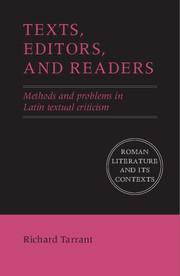Book contents
- Frontmatter
- Dedication
- Contents
- Preface
- Introduction
- 1 Textual criticism in a post-heroic age
- 2 The rhetoric of textual criticism/textual criticism as rhetoric
- 3 Establishing the text 1: recension
- 4 Establishing the text 2: conjecture
- 5 Establishing the text 3: interpolation, collaboration, and intertextuality
- 6 Textual criticism and literary criticism: the case of Propertius
- 7 Presenting the text: the critical edition and its discontents
- 8 The future: problems and prospects
- Appendix Reading a critical apparatus
- Bibliography
- General index
- Index of passages discussed
- Index of scholars
3 - Establishing the text 1: recension
Published online by Cambridge University Press: 05 March 2016
- Frontmatter
- Dedication
- Contents
- Preface
- Introduction
- 1 Textual criticism in a post-heroic age
- 2 The rhetoric of textual criticism/textual criticism as rhetoric
- 3 Establishing the text 1: recension
- 4 Establishing the text 2: conjecture
- 5 Establishing the text 3: interpolation, collaboration, and intertextuality
- 6 Textual criticism and literary criticism: the case of Propertius
- 7 Presenting the text: the critical edition and its discontents
- 8 The future: problems and prospects
- Appendix Reading a critical apparatus
- Bibliography
- General index
- Index of passages discussed
- Index of scholars
Summary
In so many respects objectivity is an illusion, and the margin of discretion is at once appealing and agonizing for the philologist. If the critical editor is not an arrogant rewriter of the text, he is constitutionally a desperate man. Philology lives by hypotheses more than by certainties, nothing but hypotheses, more or less judicious.
(Gorni (2003), 54)The Latin noun recensio, the corresponding verb recensere, and their English counterpart ‘recension’ have in the course of time conveyed a variety of meanings. These may be divided into two categories, one of which relates to the product of editorial work and the other to some part of the editorial process.
The first set of usages denotes establishing a text or creating a particular version of a text. In pre-modern contexts the term is often applied to some putatively influential form of a text, such as the so-called ‘Peisistratean recension’ of the Homeric poems (the form in which they were allegedly standardized in sixth-century Athens), or the ‘Varronian recension’ of Plautus (a product of Roman textual scholarship that involved distinguishing genuine plays from plays attributed to Plautus). In English one might similarly refer, for example, to ‘Bentley's recension’ of Horace, that is, the text of Horace created by the totality of Bentley's editorial choices, although expressions of that sort now sound rather old-fashioned.
The other usages single out particular aspects of an editor's activity. One describes the basis on which the text is established in any given place. In this sense recensio ope codicum (‘recension on the basis of manuscripts’) is distinguished from recensio ope ingenii (‘recension on the basis of conjecture’).
Recensio or ‘recension’ also relates to a prior stage of the editorial process, the method by which a critic or editor analyses the manuscript witnesses to determine how best to employ them in reconstructing the original form of the text. The most important method employed by editors of classical texts has itself gone under a variety of names: ‘genealogical analysis’ because it aims to sort manuscripts into affiliated groups and to map their descent, or ‘common error method’ because of it uses shared error to carry out that task; it is often more loosely referred to as ‘stemmatic analysis’ or ‘stemmatics and associated with the name of Karl Lachmann.
- Type
- Chapter
- Information
- Texts, Editors, and ReadersMethods and Problems in Latin Textual Criticism, pp. 49 - 64Publisher: Cambridge University PressPrint publication year: 2016



